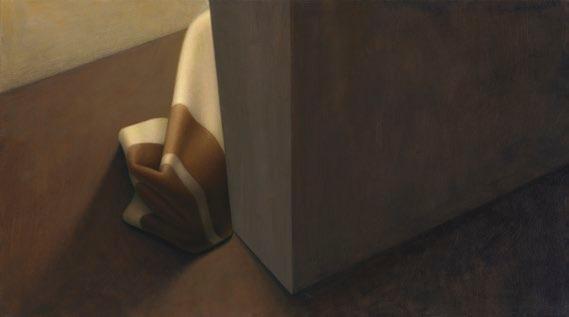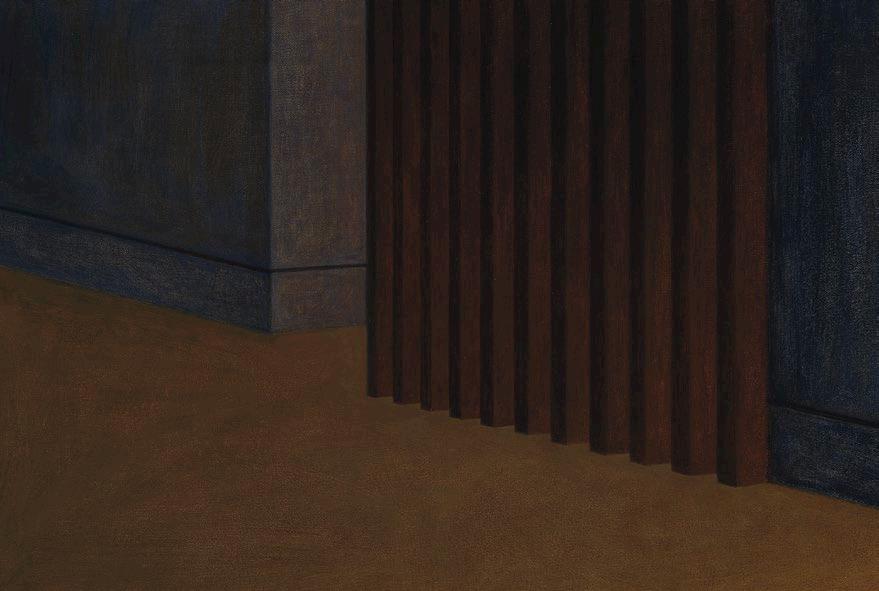The Abstraction of Reality: Still-Life and Interior Paintings by Benjamin Hazen
5,
Why Benjamin Hazen?
Because there are many who paint but few genuine artists.
As a student at the Pennsylvania Academy of the Fine Arts, he was the recipient of a most prestigious award, and his work was deemed worthy of inclusion in the Museum’s permanent collection. This accomplishment could have precipitated many highly sought opportunities. But this young artist chose to isolate himself from all distractions, disregarding what the world offered, to create.
And with sacrifice and unprecedented dedication, taking as much as a year to complete a painting, he uses non-descript interiors and familiar objects to give form to thought. His most intimate angst and urgency are spoken in a relatable imagery, and his message rises to a nearly audible potency.
He is genuine and inspired and although his paintings require the viewer’s effort, the reward will be great for those who are willing. louis m. salerno
Q UESTROYAL F INE A RT, LLC
Import a nt Ame r ican Pai n ti n g s
903 Park Avenue (at 79th Street), Third Floor, New York, NY 10075 T : (212) 744-3586 F : (212) 585-3828
HOURS : Monday–Friday 10–6, Saturday 10–5 and by appointment
EMAIL : gallery @ questroyalfineart.com www.questroyalfineart.com
An Exhibition and Sale October 18–November
2022
The Abstraction of Reality: Still-Life and Interior Paintings
by Benjamin Hazen
Benjamin Hazen views each of his works as a meditation—a reflection of his most focused and considered thoughts. The first stage of his artistic career, from 2000 to 2006, was informed by studies at Boston University and the Pennsylvania Academy of the Fine Arts. He gradually rejected the more painterly styles of most of his teachers and peers, ultimately adopting the traditional technique of “indirect painting.” In an extreme approach to this technique, Hazen now employs as many as dozens of thin, translucent paint layers. Consequently, each of his later paintings has required many months of dedicated effort.
The works that span this evolution are mesmerizing. Each earlier painting depicts an interior space with hard architectural lines, juxtaposed with isolated cloth-type objects. From 2002 to 2006, Hazen concentrated on a specific series of such works, producing a set of over one dozen interiors.
Each of these paintings—paintings that Hazen regards as “self-portraits”— utilizes a crumpled blanket or similar item to speak of the loneliness and insecurity he has felt. His paintings of this period seamlessly integrate faithful realism with earnest emotional expressiveness.
In spite of praise and recognition for these works, in 2007 Hazen stopped painting. “I had nothing additional to say,” he explains. For a time, he lost his calling as a painter. Instead, he pursued a new direction by obtaining a degree in art therapy and counseling at Drexel University. For a decade he worked with clients in Philadelphia, including many patients from underserved urban communities. Hazen views this decade of service as a mental and spiritual journey—a transition from inward doubts to a more outward-looking mindset.
In the year 2019, Hazen experienced an epiphany, imagining a dramatically new perspective on the tradition of still-life painting. His unsettling vision places the viewer beneath a glass-topped table cluttered with the familiar objects of traditional works—soft folded fabrics, hard-edged vessels, and grim reminders of mortality. Here, however, these material objects literally block the observer’s view of the pure light beyond. Once again, Hazen felt that he had something important to create on canvas. He now lives in voluntary solitude, devoting himself to his reactivated calling. Each of these new creations is a deep meditation that takes most of a year to consummate.
Hazen suggests that his earlier paintings were essentially explorations of his own sense of alienation. By contrast, his recent works “are not intentionally about me.” Rather, these new paintings look outward, seeking that which is beyond the material world. Even so, Hazen’s paintings from before 2007 and after 2020 bear meaningful similarities.
Each work exhibits a careful balance between realism and abstraction, between classical standards and personal expression, and between external and internal phenomena. Each is a strikingly original and deeply thoughtful reflection of an artist who is growing in confidence and power with each new work.
When asked, “What’s next?” Hazen replies, “I have at least 20 more paintings to complete. Each will aim higher than the last, and each will demand a year’s effort.” Judging from what has emerged thus far from his mind and hand, each will also be a masterpiece.
Biosketch: In 1998, Benjamin Hazen graduated summa cum laude from Boston University, where he earned a BFA in painting. He then attended the Pennsylvania Academy of the Fine Arts, receiving an MFA degree in 2003. As an MFA student, Hazen won the prestigious Judith McGregor Caldwell Purchase Prize, which is awarded by the Academy for the acquisition of a uniquely significant artwork worthy of inclusion in the museum’s permanent collection. In 2007, Hazen ceased painting and soon entered a degree program in art therapy and counseling at Drexel University, followed by a decade of professional practice, primarily for underserved communities in Philadelphia. He returned to painting with a new vision in 2020 and now paints full time at his home in central Pennsylvania.
* * *
Across the Hall, 2001
Oil on canvas 18 x 42 inches
As in A New Date (2000), Across the Hall (2001) evidences a more painterly style than Hazen’s later, more indirectly painted works. Here, architectural planes and partially obscured cloth items are abstracted into austere forms and colors.


Three works from 2003–2004, Threshold and Partitioned Room #1 and #2, are among the set of interiors that imply self-portraiture through fabrics. The muted palette of these works creates a false sense of calm repose, while the beautifully rendered, partially hidden blankets, lying discarded in their abstract, unadorned interiors, evoke an uneasy feeling of isolation. Pronounced lights and darks and strong compositional diagonals enhance the mystery and drama of these paintings.


Threshold, 2003 Oil on canvas 18 x 32 inches


Partitioned Room #1, 2004 Oil on canvas 18 x 32 inches Partitioned Room #2, 2004 Oil on canvas 18 x 32 inches
As 2004 progressed, Benjamin Hazen pushed his implied self-portrait series further. Closet #4 depicts a more elaborate setting and its bolder colors, clarified forms, polished lights, refined darks, and almost vertiginous perspective intensify evocations of loneliness and insecurity.

Closet #4, 2004 Oil on canvas 24 x 56 inches
Closet #5 is a masterwork of exaggerated angles, precise surfaces, and shadowy atmosphere. About this work, revered still-life painter William Bailey (1930–2020) wrote in 2005, “Closet #5 … is extraordinary. The complex perspective and sensitively modulated color create a special and mysterious place with light and air all its own.” (A photocopy of Bailey’s handwritten letter to Benjamin Hazen accompanies this work.)

Closet #5, 2005 Oil on canvas 24 x 56 inches
By 2006, Hazen’s implied self-portraits had become increasingly disturbing in the sense of alienation they convey. The crumpled red towel of Bathroom #2 is fully exposed under bright artificial light, while being surrounded by cold, geometrical forms.


Bathroom #2, 2006 Oil on canvas 18 x 32 inches
At nearly six feet in length, Office #2 is perhaps the most grand and arresting work of Benjamin Hazen’s implied self-portrait series. The yellow-striped blanket lies wadded and abandoned, in sharp contrast to the barren blue walls and rigid wooden elements. Themes of isolation are underscored by the deserted space that this painting’s widened format accommodates. Office #2 was among the final works completed before Hazen turned away from fine art and embraced a 14-year period of professional training and practice in the fields of art therapy and counseling.

Office #2, 2006 Oil on canvas 18 x 68 inches
Begun in 2020 and requiring almost a year of continuous effort to complete, Still Life #1 – Green continues a centuries-long tradition of still-life painting. Its dramatically low-angle composition, however, marks a drastic departure from genre conventions. Disorienting, subtle interplays of light and shade unveil folded fabrics and quotidian household items, while the pure green light beyond is all but hidden and inaccessible. Here, Hazen displays complete mastery of indirect painting—a painstaking and contemplative technique from which much of this work’s nuanced beauty stems.

Still Life #1 – Green, 2021 Oil on canvas 24 x 56 inches
Completed in 2022 after nine months of obsessive, dedicated labor, Still Life #2 – Red is Benjamin Hazen’s most ambitious, complex, and challenging work thus far. Red triangles of vivid light lean against enigmatic, slimly illuminated fabrics and forms. Only gradually do the three solid objects seen from beneath—a plain ceramic mug, an ornate urn, and the partial skeleton of a dog—come into focus. The viewer eventually realizes that this is a “true” scene—a meticulous and classically balanced rendering of actual items viewed from a uniquely disorienting perspective.

Still Life #2 – Red, 2022 Oil on canvas 28 x 68 inches
Katie
Eamonn

Jen
Rita
Q UESTROYAL F INE A RT, LLC Import a nt Ame r ican Pai n ti n g s 903 Park Avenue (at 79th Street), Third Floor, New York, NY 10075 T : (212) 744-3586 F : (212) 585-3828 HOURS : Monday–Friday 10–6, Saturday 10–5 and by appointment EMAIL : gallery @ questroyalfineart.com www.questroyalfineart.com Q UESTROYAL F INE A RT, LLC Louis M. Salerno, Owner Brent L. Salerno, Co-Owner Chloe Heins, Director Kayla Seifert, Gallery Manager Jesse McCloskey, Art Handler
Siede, Research Associate
Smith, Administrator
Earthman, Administrative Assistant
J. Walker, Controller OCTOBER 2022
